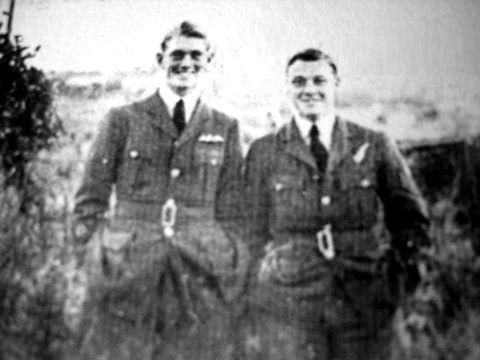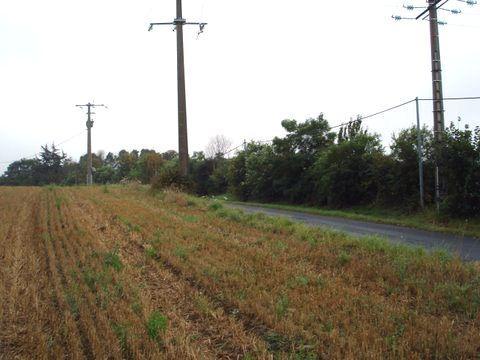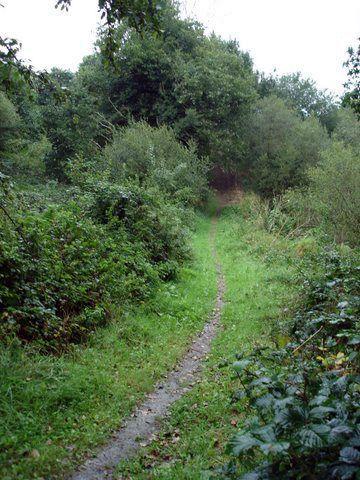De Havilland Mosquito FB VI (HP866 - code DM-D)
Pordic (22)
(contributors : Jean-Michel Martin, Jean-Michel Gravaud)

Crew : 248 Squadron RAF

- Flying Officer (pilot) Harold CORBIN (left)
- Flying Officer (navigator) Maurice WEBB (right)
THE STORY
August 14, 1944. De Havilland Mosquito FBVI - HP866, fallen at "Quévran" in Pordic (22).
On the night of August 14-15, 1944, a Royal Air Force Mosquito was returning from an anti-ship mission in the Gironde estuary. It was flown by Flying Officer Harold Corbin, assisted by Flying Officer Maurice Webb, navigator. The aircraft during the attack was hit by German Flak fire, which involved heavy impacts in three of the four tanks of the "Mossie", nickname given to the aircraft by British airmen. The pilot headed first towards Vannes, but redirected his aircraft to the North Coast, thinking he could reach an English airfield. Soon the situation became worse, and it was decided to give up and bail out before the aircraft reached the English Channel. Here are the facts told by Mister Robert Orhan and Jean Simon, witnesses at that time.

Crash site of the Mosquito at "Quévran" en Pordic
Photo Jean-Michel Martin (ABSA 39-45)
Le 14 août 1944, vers 22h30, un avion passe au dessus de Trévenais en Lantic en faisant un bruit très anormal. Presque aussitôt, c’est l’explosion. On a pu situer le point de chute en raison de la hauteur des flammes. Aussitôt, je suis parti avec Alexandre Farin et mon frère André et nous sommes arrivés au lieu de l’explosion, à "Quévran", à quelques mètres de la ferme de Monsieur Eouzan. L’avion était totalement déchiqueté et les débris occupaient une grande surface. Il y avait des gens sur place, dont le curé de Pordic qui bénissait les restes de l’avion. Et s’ils n’étaient pas morts ? Ils s’étaient jetés en parachute, avec tous les dangers qu’un saut de nuit présente tels que fils électriques et pièces d’eau, d’autant qu’ils n’avaient pas eut d’entraînement parachutiste. Tous les trois nous avons cherché dans la vallée du Rodo (Malassis), jusqu’au niveau de Quimperé.
On August 14, 1944, around 10:30 p.m., an aircraft flew over "Trévenais en Lantic", making a very surprising noise. Almost immediately, we heard an explosion. We could locate the point of fall because of the height of the flames. Immediately, I left with Alexandre Farin and my brother André and we arrived at the site of the explosion, in "Quévran", a few meters from Mr. Eouzan's farm. The aircraft was completely destroyed and the debris occupied a large area. We saw some people there, including the parish priest of Pordic who blessed the remains of the plane. What if they weren't dead ? They had bailed out, with all the dangers that a night jump presented such as electric wires or lakes, especially since they had'nt had parachute training. The three of us searched in the Rodo valley (Malassis), up to Quimperé.

Le pilote, Harold CORBIN, est tombé dans ce chemin prés du moulin de "CULERETTE" en LANTIC
The pilot, Harold CORBIN, fell in this path near the mill of "CULERETTE" en LANTIC
Photo Jean-Michel Martin (ABSA 39-45)
In vain ! We went to bed around 3 a.m. That day, August 15, my mother left for morning mass in the village. At Carpont, she saw a crowd and was informed of the presence of an English aviator. She came back to wake me up and that's how I brought him home. It was Louis Hery who brought him back to Marianne Burlot, on the frame of his bike. At around 11 a.m., Armand Guyer, who ran a bistro in Binic, came with two resistance fighters to look for him but he only agreed to leave if I went with him. At Notre Dame de la Cour, he found his navigator, Maurice Webb, who had fallen at a place called "Le Guern" and had given his parachute to Germaine Helary who, at Tréguidel, became Madame Macé, in a tailored wedding dress in the parachute. We had the honor and also the pleasure to receive them and to speak with them. They both saw their aircraft exploding in the air. The one who fell in Tréguidel thought of the pilot and the pilot thought of us "I hope that our aircraft did not kill any French". Harold Corbin's parachute was found 2 or 3 months later by Almyre Thomas, above the old "Cullerette" mill. These two airmen were hired volunteers and almost lost their lives several times (the pilot lied about ghis age and added two years to be able to enlist, in fact he was nineteen when he left for training). A few days later, their families had received official notification of their disappearance and they were not told that they had not died until the day before their return. The mother of one of them fainted when she saw him again. They came back and fight in Norway. They were specialized in attacking the German Fleet and coastal defenses. Their aircraft was a Mosquito, a very fast fighter-bomber, very well armed, and made of wood (therefore fragile), to avoid radar detections. The Germans were afraid of it. Maurice Webb and Harold Corbin were very happy to see again the places where they fell. One clearly recognized the bell tower of Notre Dame de la Cour, and the other the facade of the café at "Chez Marianne". They were very touched by the welcome they received from the town hall of Tréguidel and Lantic. To conclude, I will quote Churchill's famous phrase when speaking of the British airmen during the Battle of Britain: "Never was so much owed by so many to so few ". What would have happened to us if Hitler had conquered England ? We prefer not to think about it.
Thank you to Mr. Jean Simon for the kind authorization to publish this article which appeared in the municipal newspaper of Lantic for the month of January 1996.
Jean Michel Martin, Association Bretonne du Souvenir Aérien 39-45. 21 December 2009.
Additional note: The two airmen were picked up by the Americans on August 16, 1944 before returning to their homeland.
Crash located and documents forwarded by Jean-Michel Gravaud, member of ABSA 39-45
Ajouter un commentaire